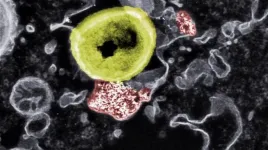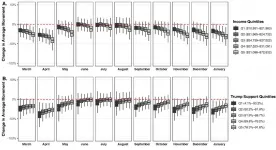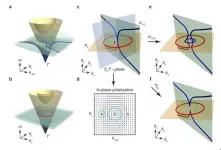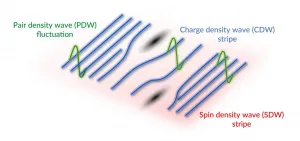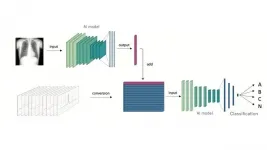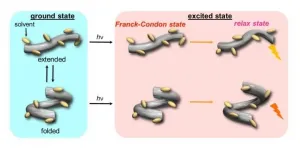(Press-News.org) In the arms race "mankind against bacteria", bacteria are currently ahead of us. Our former miracle weapons, antibiotics, are failing more and more frequently when germs use tricky maneuvers to protect themselves from the effects of these drugs. Some species even retreat into the inside of human cells, where they remain "invisible" to the immune system. These particularly dreaded pathogens include multi-resistant staphylococci (MRSA), which can cause life-threatening diseases such as sepsis or pneumonia.
In order to track down the germs in their hidouts and eliminate them, a team of researchers from Empa and ETH Zurich is now developing nanoparticles that use a completely different mode of action from conventional antibiotics: While antibiotics have difficulty in penetrating human cells, these nanoparticles, due to their small size and structure, can penetrate the membrane of affected cells. Once there, they can fight the bacteria.
Bioglass and metal
The team of Inge Herrmann and Tino Matter has used cerium oxide, a material with antibacterial and anti-inflammatory properties in its nanoparticle form. The researchers combined the nanoparticles with a bioactive ceramic material known as bioglass. Bioglass is of interest in the medical field because it has versatile regenerative properties and is used, for example, for the reconstruction of bones and soft tissues.
They then synthesized flame-made nanoparticle hybrids made of cerium oxide and bioglass. The particles have already been successfully used as wound adhesives (https://www.empa.ch/de/web/s604/empa-innovation-award-2020), whereby several interesting properties can be utilized simultaneously: Thanks to the nanoparticles, bleeding can be stopped, inflammation can be dampened and wound healing can be accelerated. In addition, the novel particles show a significant effectiveness against bacteria, while the treatment is well tolerated by human cells.
Recently, the new technology was successfully patented. The team has now published its results in the scientific journal Nanoscale in the "Emerging Investigator Collection 2021".
Destruction of germs
The researchers were able to show the interactions between the hybrid nanoparticles, the human cells and the germs using electron microscopy, among other methods. If infected cells were treated with the nanoparticles, the bacteria inside the cells began to dissolve. However, if the researchers specifically blocked the uptake of the hybrid particles, the antibacterial effect was gone.
The particles' exact mode of action is not yet fully understood. It has been shown that other metals also have antimicrobial effects. However, cerium is less toxic to human cells than, for instance, silver. Scientists currently assume that the nanoparticles affect the cell membrane of the bacteria, creating reactive oxygen species that lead to the destruction of the germs. Since the membrane of human cells is structurally different, our cells are not affected by this process.
The researchers think that resistance is less likely to develop against a mechanism of this kind. "What's more, the cerium particles regenerate over time, so that the oxidative effect of the nano-particles on the bacteria can start all over again," says Empa researcher Tino Matter. In this way, the cerium particles could have a long-lasting effect.
Next, the researchers want to analyze the interactions of the particles in the infection process in more detail in order to further optimize the structure and composition of the nanoparticles. The goal is to develop a simple, robust antibacterial agent that is effective inside infected cells.
Tricky germs
Among bacteria, there are some particularly devious pathogens that penetrate into cells and are thus invisible to the immune system. This is how they survive times when the body's defense is on alert. This phenomenon is also known for staphylococci. They can retreat into cells of the skin, connective tissue, bones and even the immune system. The mechanism of this persistence is not yet fully understood.
Staphylococci are mostly harmless germs that can be found on the skin and mucous membranes. Under certain conditions, however, the bacteria flood the body and cause severe inflammation, or even lead to toxic shock and sepsis. This makes staphylococci the main cause of death from infections with only one single type of pathogen.
The increasing number of staphylococcal infections that no longer respond to treatment with antibiotics is particularly precarious. MRSA, multi-resistant germs, are particularly feared in hospitals where, as nosocomial pathogens, they cause poorly treatable wound infections or colonize catheters and other medical equipment. In total, around 75,000 hospital infections occur in Switzerland every year, 12,000 of which are fatal.
Cerium: Jack-of-all-trades among the chemical elements
The chemical element cerium was unjustly named after the dwarf planet Ceres; the silvery metal is currently making a big splash. As cerium oxide, it is incorporated into car catalytic converters, and it is also used in the manufacture of products as diverse as self-cleaning ovens, windscreens and light-emitting diodes (LEDs). Its antimicrobial and anti-inflammatory properties also make it interesting for medical applications.
INFORMATION:
BOSTON - For many patients with localized lung cancer (non-small-cell lung carcinoma and small cell lung carcinoma), high-dose radiation with concurrent chemotherapy is a potential cure. Yet this treatment can cause severe, acute inflammation of the esophagus (esophagitis) in about one in five patients, requiring hospitalization and placement of a feeding tube.
A team of radiation oncologists at Mass General Cancer Center demonstrate in an early clinical trial that the radiation beam can be carefully "sculpted" to deliver the majority of a radiation dose directly to the tumor while effectively sparing tissues in the side of the ...
Ann Arbor, April 22, 2021 - Using nearly a year of anonymous geolocation data from 15-17 million cell phone users in 3,037 United States counties, investigators have found that individuals with lower income per capita or greater Republican orientation were associated with significantly reduced social distancing throughout the study period from March 2020 through January 2021. Their findings are reported in the American Journal of Preventive Medicine, published by Elsevier.
The associations persisted after adjusting for a variety of county-level demographic and socioeconomic characteristics. Other county-level characteristics, such as the share of Black and Hispanic residents, were also associated ...
Topological photonics has attracted a lot of attention recently. The application of topological band theory to photonics not only opens the door to novel devices, but also stimulates the exploration of new topological phases. In the photonic regime, symmetries that are unique to electromagnetic (EM) waves can intrinsically protect the band degeneracies in the momentum space. Topological systems realized using such symmetries are uniquely "photonic", having no counterparts in electronic or phononic systems.
Among various topological features in momentum space, nodal chain is a special ...
Guilt and social pressure lead people to underreport COVID-19 protocol violations, according to study of experimental data across 12 countries.
Article Title: A guilt-free strategy increases self-reported non-compliance with COVID-19 preventive measures: Experimental evidence from 12 countries
Funding: J.-F. Daoust acknowledges the financial support from SSPS Open Access (University of Edinburgh). M. Foucault and S. Brouard acknowledge the financial support from ANR - REPEAT grant (Special COVID-19), CNRS, Fondation de l'innovation politique, as well as regions Nouvelle-Aquitaine and Occitanie. Richard Nadeau and Éric Bélanger acknowledge the financial support from the Social Sciences and Humanities Research Council (SSHRC/CRSH). M. Becher gratefully acknowledges ...
Unconventional superconductors contain a number of exotic phases of matter that are thought to play a role, for better or worse, in their ability to conduct electricity with 100% efficiency at much higher temperatures than scientists had thought possible - although still far short of the temperatures that would allow their wide deployment in perfectly efficient power lines, maglev trains and so on.
Now scientists at the Department of Energy's SLAC National Accelerator Laboratory have glimpsed the signature of one of those phases, known as pair-density waves or PDW, and confirmed that it's intertwined with another phase known as charge density wave (CDW) stripes - wavelike patterns of higher and lower ...
Substantial proportions of pregnant and postpartum women scored high for symptoms of anxiety, depression, loneliness and post-traumatic stress in relation to COVID-19 in a survey carried out in May and June 2020, according to a new study published this week in the open-access journal PLOS ONE by Karestan Koenen and Archana Basu of Harvard T.H. Chan School of Public Health, US, and colleagues.
Pregnant and postpartum women face unique challenges during the COVID-19 pandemic that may put them at elevated risk of mental health problems. These include concerns about ...
Time seems to pass more slowly in the UK COVID-19 lockdown - especially for people who are depressed, shielding or dissatisfied with social interactions
INFORMATION:
Article Title: Distortions to the passage of time during England's second national lockdown: A role for depression
Funding: The author received no specific funding for this work.
Competing Interests: The authors have declared that no competing interests exist.
Article URL: https://journals.plos.org/plosone/article?id=10.1371/journal.pone.0250412
...
Survey of 3,536 healthcare workers suggests 67 percent are suffering burnout, but people who receive frequent COVID-19 tests are less likely to be burned out.
INFORMATION:
Article Title: Determinants of burnout and other aspects of psychological well-being in healthcare workers during the Covid-19 pandemic: A multinational cross-sectional study
Funding: JK has received an educational grant from Johnson and Johnson.
Competing Interests: JK has received an educational grant from Johnson and Johnson. This does not alter our adherence to PLOS ONE ...
Kobe University Hospital's Dr. NISHIMORI Makoto and Project Assistant Professor KIUCHI Kunihiko et al. (of the Division of Cardiovascular Medicine, Department of Internal Medicine) have developed an AI that uses multiple kinds of test data to predict the location of surplus pathways in the heart called 'accessory pathways', which cause the heart to beat irregularly. In this study, the researchers were able to improve diagnosis accuracy by having the AI learn from two completely different types of test results- electrocardiography (ECG) data and X-ray images. It is hoped that this methodology can be applied to other disorders based upon the successful results of this research.
These ...
Stimulus-responsive supramolecular structures have emerged as an alternative to conventional ones, owing to their applications in sensing, drug delivery, and switchable memory systems. Now, scientists at Tokyo Institute of Technology explore the hydrostatic-pressure response of "foldamers"--artificial molecules that mimic protein folding--and report a shift in their preferred conformation with changing pressure, demonstrating hydrostatic pressure-enabled dynamic control. The finding opens doors to future development of pressure-sensitive foldamers and artificial materials.
Most, if not all, biological systems are extremely complex and often rely on interactions traditional ...
